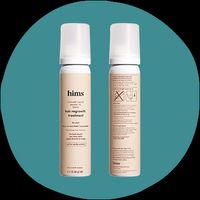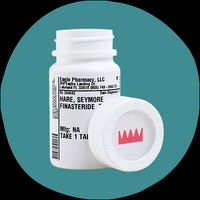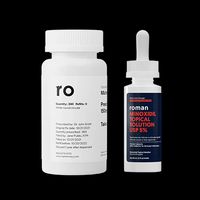Hair loss treatments for men vary, from transplants and lasers to medications such as minoxidil and finasteride. If you’re looking for the most effective option, read on to see our picks along with their benefits, risks, and costs.

A quick look at the best hair loss treatments for men
- Prescription and over-the-counter (OTC) medications
- Minoxidil (Rogaine)
- Finasteride (Propecia, Proscar)
- Combination minoxidil and finasteride
- Hair transplants
- Laser treatments
- Lifestyle changes
- Natural remedies
Hims Hair Loss Treatments
4.8 (41k+) from App Store

- Type: compounded topical spray
- Active ingredients: 0.3% finasteride, 6% minoxidil
- Prescription needed: yes
Editor’s take
Hims Topical Finasteride & Minoxidil Spray is created by a process called compounding. Compounded medications are customized or altered to meet a specific need (in this case, mixing two active ingredients into one topical product). While compounded medications like this one use ingredients that are FDA-approved in other medications, this specific product isn’t FDA-approved.
Language matters
In this article, we use the terms “male” and “female” to refer to someone’s sex as determined by their chromosomes, and “men” and “women” when referring to their gender (unless quoting from sources that use nonspecific language).
Sex is determined by chromosomes, and gender is a social construct that can vary across time periods and cultures. Both of these aspects are acknowledged to exist on a spectrum, both historically and by modern scientific consensus.
Which hair loss treatment is best for men?
It can be difficult to say which is the best hair loss treatment for males. While some people may see strong results with a certain proven treatment, it’s possible that the same treatment won’t work for you or that you’ll experience side effects that prevent you from wanting to continue the treatment.
To help you find the best treatment for your hair loss, we’ve collected a wide array of possible treatments, including prescription medications, OTC treatments, natural treatments, hair transplants, and even some lifestyle changes that you can start right away.
Here’s our deep dive into some of the best hair loss treatments available in 2024.
Prescription and OTC medications
The Food and Drug Administration (FDA) has approved two medications to treat male pattern baldness:
Minoxidil (Rogaine)
Rogaine is available over the counter as a liquid or foam in Men’s Rogaine and Women’s Rogaine formulas. You apply it to your scalp twice per day to help encourage hair growth and prevent hair loss. Minoxidil is the active ingredient in Rogaine, and it’s also available in a generic form as a liquid solution or an oral tablet.
Both Rogaine and minoxidil can take 4–6 months to show results. Results also depend on proper application and dosage.
Hims 5% Topical Minoxidil Foam
3.5 (65+) from Hims

- Type: topical foam
- Prescription needed: no
- Key ingredient: 5% minoxidil
Subscribe and save
Healthline’s review
Hims is an online service that can send OTC and prescription treatments right to your home. While you will need a prescription for some hair loss products, this 5% minoxidil foam can be purchased without a prescription.
This bottle is priced at $30 and is intended to last 1 month when used as directed. However, Hims offers a significant discount if you buy a 3-month supply (3 bottles), bringing the price down to $20 per bottle.
Pros & cons
Product details
Finasteride (Propecia, Proscar)
Finasteride is a pill you take every day. It’s available only with a prescription from your doctor. The FDA states that the drug will generally take at least 3 months of daily use to show results.
Keeps Finasteride 1 mg Hair Loss Medication
4.7 (5.3k+) from Keeps

- Type: pill
- Prescription needed: yes
- Key ingredient: 1 mg of finasteride per tablet
Healthline’s review
Keeps offers a wide variety of products for hair loss and hair thinning, including prescription medications and OTC products. For anyone not interested in topical treatments such as liquid or foam minoxidil, finasteride (generic Propecia) is a daily prescription tablet that can help reverse hair loss and encourage hair regrowth.
Keeps offers a 3-, 6-, or 12-month supply, and you can save a little extra money per month when buying in bulk. For example, a 3-month supply costs $26.67 per month, and a 12-month supply costs only $20 per month. An additional discount may be available for first-time buyers.
Pros & cons
Product details
Combination minoxidil and finasteride
Some people experiencing hair loss may benefit from combining minoxidil and finasteride in a prescription treatment. While minoxidil is available over the counter, the highest available concentration is 5%. A prescription is required for anything above 5%.
Through services such as Roman, Hims, Keeps, and Happy Head, subscribers can be evaluated to see whether they would benefit from this treatment and a minoxidil concentration above 5%.
Roman Finasteride & Minoxidil Topical

- Type: topical solution
- Prescription needed: no
- Key ingredients: finasteride, minoxidil
Healthline’s review
Roman features a large number of health-focused products for health concerns such as erectile dysfunction, hair loss, weight management, and premature ejaculation.
For those experiencing hair loss, Roman offers a prescription topical spray treatment that combines minoxidil, finasteride, and tretinoin. This 3-in-1 treatment can easily be sprayed onto the affected area of your scalp.
While it will take some time to show results (and not every user will see results with this treatment), you may begin seeing hair regrowth in 3–6 months.
Pros & cons
Product details
For both minoxidil and finasteride, it may take up to 1 year to see results, and you’ll need to keep taking them to maintain the benefits.
Can I buy hair loss medication online?
You can buy many of the most popular hair loss medications online and, in most cases, have them shipped discreetly to your home. Here are our reviews of some of the top places to buy these medications online, including a closer look at how they compare:
- Keeps Review 2023: How Well Does It Work for Hair Loss?
- Hims Hair Loss Treatment Review
- Hims vs. Keeps: Which Hair Loss Subscription Is Right for You?
- A 2023 Review of Happy Head for Hair Loss: Does it Actually Work?
Hair transplants
The two most popular hair transplant procedures are follicular unit transplantation and follicular unit extraction, according to a research articleTrusted Source from 2021.
Both procedures are considered surgery, so they can be expensive and may cause some level of discomfort.
There are also certain risks, including infections and scarring. You may need to do multiple hair transplant treatments to get your desired outcome.
Follicular unit transplantation (FUT)
FUT is the more “classic” method and may also be called strip harvesting by some medical professionals. It involves removing some skin — typically from the back of your scalp, where there’s an abundance of hair. A surgeon then removes the hair follicles from that strip of skin and reinserts them into the part of your scalp where you’re experiencing hair loss.
Follicular unit extraction (FUE)
In FUE, a technique sometimes also known as punch or punch harvesting, a surgeon removes hair follicles directly from your scalp and transplants them into the bald parts of your scalp. Direct hair implantation is a modified version of this technique in which a specialized tool is used to complete the procedure.

Personalized hair regrowth for men with Hims
Access doctor-trusted ingredients like finasteride and minoxidil. Complete an online assessment, get a custom plan, and see results in as few as 3 to 6 months. No insurance required.
Laser treatment
Laser treatment is thought to help reduce the inflammation in hair follicles that prevents regrowth in some types of hair loss, such as alopecia areata.
There are limited studies to support the effectiveness of laser treatments for hair loss. But a 2016 reviewTrusted Source indicates that low level laser therapy (LLLT) is safe and effective when used to treat male pattern hair loss. According to a 2019 reviewTrusted Source, more research on LLLT is still needed.
Lifestyle changes
Quit smoking
If you smoke, you’ve likely heard about the negative effects smoking has on your lungs. But did you know that smoking may be associated with hair loss as well?
A 2021 studyTrusted Source involving 1,000 men found that the majority of participants who smoked had some degree of hair loss, while less than half of the participants who did not smoke had hair loss.
If you smoke, quitting may help decrease hair loss.
Try scalp massage
Not only do massages feel wonderful, but they may help with hair loss too. Massaging your scalp stimulates your hair follicles.
In a small 2016 studyTrusted Source, healthy Japanese men who received 4 minutes of scalp massage each day for 24 weeks had thicker hair at the end of the study.
Research from 2019 also found that scalp massages were associated with self-perceived improvements in hair density.
Eat a balanced diet
A balanced diet may help keep your hair healthy. It’s important to include a variety of vegetables, fruits, whole grains, unsaturated fats, and lean proteins in your diet. Limiting your consumption of sweets is also helpful.
A 2019 research reviewTrusted Source suggests an association between certain vitamins and minerals found in food and healthy hair. Consider adding some of these foods to your diet:
- iron-rich foods, including lean beef, beans, green leafy vegetables, iron-fortified grains, and eggs
- foods rich in omega-3 fatty acids, such as salmon, mackerel, tuna, flaxseed, egg yolks, hemp seeds, and walnuts
- high protein foods, such as eggs, lean meats, and seafood
Drinking plenty of water is also an important part of a balanced diet.
Try to reduce stress
Stress can have negative effects on your body, including your hair, and can lead to hair loss.
Strategies that may help reduce stress include:
- regular physical activity such as exercising
- listening to music
- practicing yoga
- meditating
- getting enough sleep
Natural remedies
Oils
Some evidence from a 2014 mice studyTrusted Source suggests that peppermint oil may help with hair growth.
Rosemary oil has also been traditionally used to increase blood circulation in the scalp. A 2013 studyTrusted Source indicated that rosemary leaf extract improved hair regrowth in mice.
Saw palmetto
Saw palmetto is a plant with small berries.
While research is sparse on saw palmetto’s ability to treat hair loss, a 2020 reviewTrusted Source suggests that it may help with hair growth while causing few side effects.
Biotin
Biotin is a vitamin found naturally in foods such as nuts, avocados, sweet potatoes, eggs, onions, and oats.
There’s some evidence that taking biotin may help slow down hair loss, but most of the researchTrusted Source has been done in women with a biotin deficiency. There is a lack of evidenceTrusted Source to suggest that supplementing with biotin has a noticeable effect in people without a deficiency.
Want to learn about other foods containing biotin? Here’s our list of the top biotin-rich foods.
Onion juice
A small 2002 studyTrusted Source found that the use of onion juice as a topical treatment resulted in significantly more regrowth than just tap water in people with patchy alopecia areata. But more research on people with male pattern hair loss is needed.
Bhringraj
Bhringraj (Eclipta alba), also called false daisy, is a species in the sunflower family. In Ayurvedic medicine, it’s known as an herb that supports hair growth.
A rat study from 2008Trusted Source showed that extracts of the herb resulted in better hair regrowth than minoxidil. However, more research is needed to find out whether these effects would occur in humans.
Green tea
Another purported herbal remedy for hair loss is green tea.
In a 2005 study in miceTrusted Source, the polyphenolic compounds present in green tea showed promise as a natural remedy for hair loss. But there have not been any studies in humans to confirm these effects.
Hibiscus
Chinese hibiscus (Hibiscus rosa-sinensis) is marketed widely in India for hair growth. A 2003 study in miceTrusted Source showed positive effects on hair follicles, but no studies have been done in humans.
Looking for more hair growth products to treat hair loss and thinning? We compared over-the-counter and prescription treatments to find the 9 Best Hair Growth Products for Hair Loss and Thinning of 2024
What causes thinning hair or hair loss in males?
Hair loss could be caused by any of the factors mentioned below.
Genetics and family history
If your relatives have hair loss, you’re more likely to develop it. Male pattern baldness, or androgenic alopecia, is a genetic condition that causes gradual hair loss. This could show up as a slowing receding hairline or thinning patches on the crown of your head.
Medical conditions
Some medical conditions, such as hormonal conditions and autoimmune diseases, cause hair loss.
For example, thyroid problems, scalp infections, or trichotillomania (a hair-pulling disorder) could lead to thinning hair or bald patches.
An autoimmune condition called alopecia areata develops when your immune system attacks hair follicles, resulting in bald patches.
Medications and medical treatments
Hair loss is a potential side effect of several medications for diseases such as cancer, depression, gout, heart disease, and arthritis.
Stress
Chronic stress or stressful events could lead to temporary hair thinning.
What is male pattern baldness?
Male pattern baldness, also known as androgenic alopecia, is an inherited trait that affects more than half of men over 50 years old.
It’s typical to lose 50–100 hairs per day. Usually, this loss isn’t noticeable because new hair grows to replace the lost hair. Hair loss and baldness occur when hair falls out too quickly or new hairs stop growing.
Depending on the cause of hair loss, you may notice slowly thinning hair or a sudden bald patch. Hair loss can affect the hair on only your scalp or on your whole body.
When to talk with a doctor about hair loss
Consider seeing a doctor if you:
- experience sudden patchy hair loss
- think a medication may be causing your hair loss
- also have a rash
- have scaly skin
The following conditions could lead to hair loss:
- diabetes
- lupus
- lichen planus
- sarcoidosis
- scalp psoriasis
- alopecia areata
- thyroid conditions
- eating disorders
- iron deficiency anemia
- trichotillomania
- celiac disease
- syphilis
If you have any of these conditions or if you’re experiencing other symptoms besides hair loss, talk with a doctor about treating underlying conditions. Your hair loss should improve as your condition improves.
Certain medications can also lead to hair loss, including:
- chemotherapy and radiation treatments
- some blood thinners (anticoagulants)
- some depression medications
- medications used to treat high blood pressure
- some heart medications
- gout medications
- isotretinoin (Accutane), an acne treatment
A note on prescription medications
Talk with your doctor before stopping or changing a medication you’re currently taking.
Can I reverse or prevent hair loss?
If you’ve started noticing thinning hair or you have a family history of male pattern baldness, you may not be able to completely stop your hair loss. But you may be able to slow or prevent it.
Consider trying these tips to help prevent hair loss in males:
- Find ways to lower your stress levels.
- Support your overall health by eating a nutritious diet and staying physically active.
- Avoid hairstyles that tug and pull on your hair.
- Use hair products that may help prevent hair loss.
- Avoid smoking.
- Try scalp massages.
- Talk with a healthcare professional to see whether any medications or medical conditions could be increasing your hair loss.
How much does hair loss treatment cost?
The cost of hair loss treatment depends on which treatment you decide to try.
For example:
- Brand-name Rogaine can cost around $47 for a 3-month supply, while generic minoxidil treatments can cost around $51 for a 3-month supply.
- Brand-name Propecia prices start as low as $115 for a 1-month supply, while the generic version (finasteride) is available at a potentially lower cost through companies such as Roman for $20 per month and Keeps for around $27 per month.
- Hair transplants can cost anywhere from $3,000 to $15,000.
Generic medications and OTC supplements tend to be less expensive.
Frequently asked questions about hair loss treatments for men
What is the best treatment for male hair loss?
Do hair loss treatments actually work?
What happens if I stop hair loss treatment?
How can I permanently treat hair loss?
Can you actually stop hair loss? Can hair grow back after balding?
Takeaway
There are several treatments you may want to try for hair loss, including OTC and prescription medications, hair implants, and home remedies.
Talk with a doctor first. They can help you figure out the cause of your hair loss and decide what the best treatment option might be.




